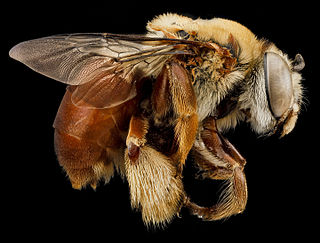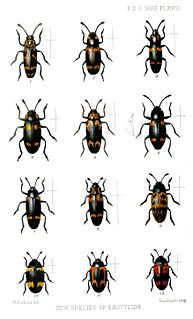Triplax californica is a species of pleasing fungus beetle in the family Erotylidae. It is found in North America.

Triplax is a genus of pleasing fungus beetles in the family Erotylidae. There are about 18 described species in Triplax.
Himatium errans is a species of snout or bark beetle in the family Curculionidae. It is found in North America.

Triplax festiva is a species of pleasing fungus beetle in the family Erotylidae. It is found in North America.

Centris errans, known generally as wandering centris, is a species of centridine bee in the family Apidae. Other common names include the Florida locust-berry oil-collecting bee and spiny bear's-breech. It is found in the Caribbean and North America. The species is one of five from the family Apidae that are endemic to the state of Florida. The species occurs the southernmost portion of Florida.
Triplax dissimulator is a species of pleasing fungus beetle in the family Erotylidae. It is found in North America.

Lepyrus is a genus of true weevils in the beetle family Curculionidae. There are more than 70 described species in Lepyrus.
Triplax marcescens is a species of pleasing fungus beetle in the family Erotylidae. It is found in North America.
Anisotoma errans is a species of round fungus beetle in the family Leiodidae. It is found in North America.
Triplax flavicollis is a species of pleasing fungus beetle in the family Erotylidae. It is found in Central America and North America.
Lyroda is a genus of square-headed wasps in the family Crabronidae. There are more than 20 described species in Lyroda.
Triplax frontalis, the black-headed pleasing fungus beetle, is a species of pleasing fungus beetle in the family Erotylidae. It is found in North America.
Triplax frosti is a species of pleasing fungus beetle in the family Erotylidae. It is found in North America.
Triplax thoracica is a species of pleasing fungus beetle in the family Erotylidae. It is found in North America.
Triplax macra is a species of pleasing fungus beetle in the family Erotylidae. It is found in North America.
Triplax puncticeps is a species of pleasing fungus beetle in the family Erotylidae. It is found in North America.
Triplax mesosternalis is a species of pleasing fungus beetle in the family Erotylidae. It is found in Central America and North America.
Triplax wehrlei is a species of pleasing fungus beetle in the family Erotylidae. It is found in Central America and North America.
Carcinonemertes errans is a ribbon worm in the family Carcinonemertidae. It lives in symbiosis with the Dungeness crab, consuming the crab's developing eggs. In 1980 it was implicated in the collapse of the Dungeness crab fishery in central California.
Acestridium triplax is a species of armored catfish in the genus Acestridium. It is native to the Amazon River in Brazil.




